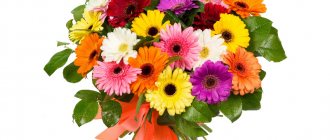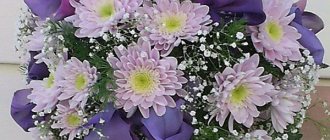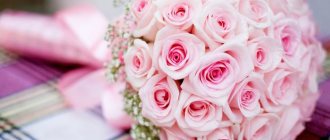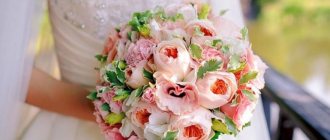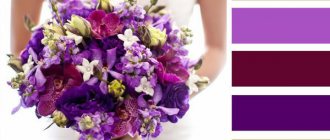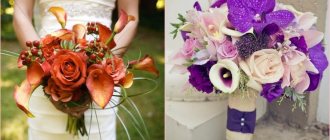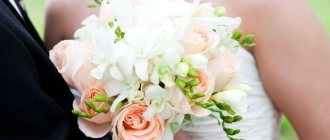For a long time, chrysanthemums were undeservedly considered “unworthy” of proximity to the queen rose. However, it is the most common flower of the Eurasian continent, native to China, where it is still used in alternative medicine. Initially, it migrated to Japan, where it was rightfully recognized as a symbol of the imperial house. In the 17th century, the chrysanthemum was brought to Europe, and by the mid-19th century to Russia.
The combination of white roses and chrysanthemums of various colors in one bouquet looks elegant and colorful. In Japan, the yellow “golden-colored” chrysanthemum is included in the national symbols, where it is depicted on coins, the country’s coat of arms, and the seal of the Imperial House.
In autumn, bouquets using chrysanthemums in combination with other flowers, cereals, and herbs become the most popular. It is unpretentious and retains its freshness and elasticity for a long time.
Bouquet of chrysanthemums and cereals
What to combine with
The most popular combination of chrysanthemums and roses. Used in the following tint tandems:
- Roses and chrysanthemums in white, cream, and pink shades are used for wedding compositions or as a gift to a young, sophisticated nature. This arrangement of flowers symbolizes innocence and purity.
- The combination of white and blue shades looks dynamic and catchy. Used for wedding ceremonies, when the rest of the paraphernalia includes blue and blue colors. It harmonizes well with a boutonniere in the same colors for the groom or when he is wearing a dark blue suit. The sapphire color in the bride's bouquet symbolizes fidelity and constancy of feelings.
- Green bouquets have begun to enjoy particular popularity, and breeders are helping with this. Tandems of light green roses and emerald chrysanthemums symbolize tenderness, youth, and the beginning of a new life. It is appropriate to give such a bouquet to a young mother in honor of the birth of a baby or to a charming girl when proposing marriage.
- The combination of white and yellow shades is often used in wedding ceremonies. Attributing subsequent separation and parting to the yellow color of the buds is becoming a thing of the past. The symbolism regarding this color turned towards the east. Bouquets with “golden” tones are presented as a gift to a woman or man with a hint of improved material well-being and a wish for longevity.
- The presence of white and red flowers in the bouquet suits girls with a catchy, expressive appearance. Deep red shades reflect the passion of nature and ardent temperament. But the use of exclusively bright tones in a composition can draw all attention to itself, which is why combinations of white chrysanthemums with red roses or vice versa are common.
Bouquet of red roses and white chrysanthemums
Bouquets of roses and chrysanthemums are diversified by including greenery and cereals. Good for this:
- asparagus;
- fern;
- bergrass;
- ruscus;
- aspidistra;
- Aralia.
The main thing to take into account is that there should not be too much greenery, unless it is the main active object in the bouquet. Wheat, rye, and other ripe ears are added to autumn compositions as a wish for abundance and fertility.
In addition to the choice of colors themselves, great importance is attached to their quantity. It is traditionally believed that large ones are counted by buds, and those in which the inflorescences are collected in baskets are counted by branches.
Beautiful forms of wedding composition
For small white chrysanthemums, a wonderful option is the classic hemisphere for a wedding bouquet, which will create a delicate decoration for a young bride. Small multi-colored chrysanthemums will look beautiful in slight disorder and asymmetry, but only if it is a mono-bouquet - diluting with roses or orchids requires exquisite beauty and clear order, again in the form of a hemisphere or a classic even bouquet.
Classic bouquet in the shape of a hemisphere
The best option would be, as in the case of gerberas, a basket. A neat little wicker decoration with a cap of fluffy flowers peeking out - it’s so original and cute!
Blue shades
When the task is set to create a bouquet of bright blue flowers, the question arises whether this plant has blue shades in its palette. In the early 2000s, Japanese scientists managed to develop blue chrysanthemums using genetic engineering. They achieved this by introducing the anthocyanin gene from the blue bell and clitoria (moth pea) into the DNA of the red flower. The plants obtained through this modification have buds in the color range from sky blue to deep indigo. However, the import of genetically modified plants into Russia is prohibited, so florists will not soon use “natural” blue flowers.
For now, to get blue flowers, you can use this method:
- Freshly cut chrysanthemums with dense flowers of white, light beige and soft cream shades are suitable for coloring.
- A packet of blue food coloring is diluted in a jar of cold water, stirring until no sediment remains. The density of the color will depend on the saturation of the solution and the time the plant spent in the liquid.
- Using a sharp floral knife, cut the stems of chrysanthemums at an angle of 45°.
- Make a longitudinal thin cut along the stem, carefully so as not to damage the structure of the stem.
- Place all prepared chrysanthemums in a jar for 8-20 hours, removing the branches when sufficient coloring occurs. The faster it is extracted, the lighter the shades.
During the painting period, the room should be light and warm, air humidity should be reduced to the maximum. When you want to get flowers of different shades on one stem, proceed as follows:
- the stem is split into several separate segments;
- each is placed in a separate container with dye of different concentrations;
- last for different times.
This achieves the effect of a transition of shades from sky blue to ultramarine on one branch, which looks like a full-fledged bouquet when decorated.
How to keep a bouquet fresh for a long time
When creating a composition using chrysanthemums and roses, pay attention to several features of caring for each type of included flowers:
- For bouquets, only open chrysanthemum buds are used; if they stand in water for a long time, closed ones will still not bloom. Roses are in buds and open.
- The lower leaves on the stems of all plants are cut off immediately to avoid contamination upon contact with water and premature stagnation. You can add a few crushed acetylsalicylic acid tablets, a spoon or two of sugar, and citric acid to the vase.
- All dying petals on plants are removed in time, avoiding contact with elastic and fresh ones, so the stem will retain its original appearance longer.
- The lower edge of the chrysanthemum stem is cut lengthwise several times to increase the access of absorbed water. The rose is pruned at an acute angle of 45°, and the procedure is repeated daily, maximum every other day.
- The place for the bouquet is chosen to be cool, without direct sunlight, and not in a draft. Away from a heater, air conditioner or window. Daily irrigation of the bouquet with a spray bottle will extend its life. They take into account the fact that chrysanthemums can withstand lower temperatures than roses, so it is not advisable to take a mixed bouquet to an uninsulated balcony in winter.
- If the chrysanthemums are slightly wilted, they are placed under hot and then cold running water for 5-10 minutes. After this, place it in a vase with water at a temperature of 25°C.
Most often, it happens that roses die earlier, but chrysanthemums continue to delight the eye with their appearance. In this case, it is recommended to remove the withered flowers, leaving only resilient plants in the vase. In this case, be sure to change the water and wash the container under a hot stream. The lifespan of cut chrysanthemum varies from 3 weeks to 6.
Bouquet of pink roses and white chrysanthemums
Chrysanthemums and wedding
Fresh flowers can transform any holiday into a fairy tale. No wedding is complete without flowers. In combination with tenderness, romance, purity, florists pursue the idea of creating luxury and celebration.
Against the general background of the availability of any flower arrangement, a bouquet of chrysanthemums does not lose its relevance. They are harmoniously placed around the perimeter of the room, as well as on guest tables.
Chrysanthemum rightfully takes its place of honor - the attractiveness and freshness of the flower are preserved for a very long time. The lightness and airiness of the flower are reminiscent of the legend that it symbolizes eternal youth and beauty.
Be that as it may, we are dealing with a cut plant. To make a bouquet of chrysanthemums last longer, you need to follow the rules:
- flowers should be broken rather than cut;
- if a cut is unavoidable, it should be at an oblique angle. This can be easily done with pointed pruning shears.
From a flower that has bloomed three-quarters, shoots are removed, leaving up to three to four leaves below. The procedure is performed in the morning or evening. When immersing a bouquet of chrysanthemums in water (photos of which you see in our article), throw an aspirin tablet or a pinch of salt into the container.
Water should not exceed half the length of the stems. Where the water is chlorinated, it is advisable to take the settled liquid. Some people resort to this trick: they add a little solution of potassium permanganate or lapis to the water.
Minimalism for the discerning person
The combination of white roses and green chrysanthemums in a multi-level bouquet reveals the beauty of each element. Including leafy plants will complete the look, making it complete. To create a composition you will need:
- white roses 5 pcs;
- aspidistra greens;
- sprigs of green chrysanthemum 2-4 pieces, depending on the density of the inflorescences;
- phoenix leaf;
- green tape;
- ribbon for decoration;
- pruning shears or florist knife;
- organza: white, creamy pink or soft green.
Step-by-step instructions for creating a vertical composition:
- We prepare roses by cutting stems of different lengths: leave one as long as 45-50 cm, two – 35-30, two – 10-15. The cuts are made with a knife or pruning shears at an acute angle. Leave the flowers in the vase to saturate them with moisture.
- We shorten the branches of chrysanthemum, aspidistra, and phoenix in height.
- We place a phoenix leaf on the table. Place the longest rose on top, then two with shorter stems. On the third row we place green chrysanthemums, and below are the shortest roses. We connect all the elements using tape, tightening them tightly to make the structure static.
- We lay aspidistra leaves along the outer edge, folding some of them in half.
- We decorate the bottom using organza or other packaging material. We fold the material in several layers to increase density.
- We fix the lower part of the bouquet by wrapping it with decorative ribbon. If desired, tie a beautiful bow or leave the edges hanging freely.
Decoration elements
Chrysanthemums are extremely unpretentious and, due to their discreet beauty, can be combined with literally any decor. The best, of course, is greenery - it always looks natural and organic. But besides this, ribbons, crystal rhinestones, pearls, and decorated pins can gracefully complement your bouquet.
Sometimes florists tint some chrysanthemums in a bouquet, giving them a unique color, which in itself is an interesting decoration for the composition. The downside is that flowers painted (through the stem or with a spray) live much shorter than their natural counterparts.
It would be bad form to decorate flowers with sparkles, but for some reason this particular type of decoration is very popular among chrysanthemums. Glitter will greatly vulgarize the wedding bouquet, but you don’t need it at all, do you?
Here are a few more flowers that you should definitely pay attention to when choosing a wedding bouquet: freesias, daisies, lilies, hydrangeas, peonies, roses, wildflowers, orchids, calla lilies, gerberas, ranunculus, peony roses.
Master class on spiral technology
Spiral technology is easy to transport and hand to the recipient. The composition fits well into a vase or even a bucket, in the case of a large number of bouquets presented at the same time.
For the spiral composition you need to prepare:
- large white roses;
- small green and pink chrysanthemums on branches;
- ruscus greens;
- multi-colored eustomas;
- bush blue carnations;
- wide tape for fixation;
- interlining.
First, let's take a few different flowers and a sprig of ruscus greens. Let's place them harmoniously relative to each other. This will be the center of the future bouquet.
We alternately place carnations, roses, and eustomas of different shades so that neighboring plants differ in color and shape. We place the plant stems not strictly vertically, but at a slight angle. We twist each next row in a spiral.
We tie the stems with decorative tape, pulling them tightly together. For small compositions you will need only 4-5 turns, and for large and heavy ones at least 10.
Using pruning shears, we give the same length to all stems so that the bouquet looks neat and tidy.
The composition using the spiral technique is stable even without a vase; it has the correct balancing and center of gravity.
To complete the look, we will pack the bouquet in several layers of non-woven fabric, which will highlight the entire color scheme of the composition. Tie the outer edge with bright ribbon or raffia.
